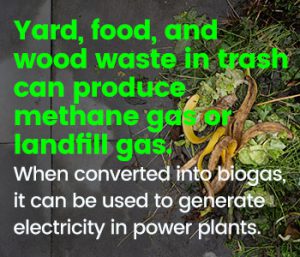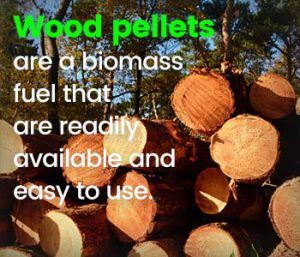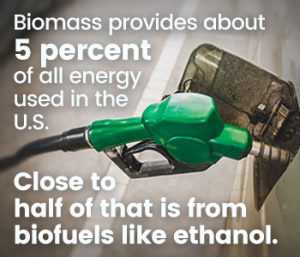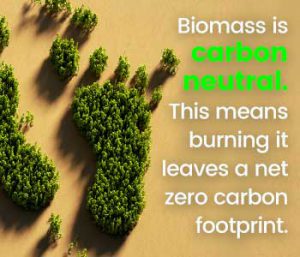You might know that wood pellets are a type of biomass fuel. But what is biomass? Learn more about this renewable energy source.
According to information from the U.S. Energy Information Administration, biomass refers to organic material that comes from animals and plants and is used as a source of energy. Biomass can contain energy from the sun. For example, wood is a kind of biomass because it requires the sun to grow.
What Does Biomass Mean?
 Biomass refers to organic material that is used as a source of energy. If you burn biomass, the energy is released as heat. This means that if you burn wood pellets in your pellet stove, you are burning biomass. Wood pellets are an organic energy source and the energy is released as heat. This heat can be used to do things like heat a home or business or even power a generator.
Biomass refers to organic material that is used as a source of energy. If you burn biomass, the energy is released as heat. This means that if you burn wood pellets in your pellet stove, you are burning biomass. Wood pellets are an organic energy source and the energy is released as heat. This heat can be used to do things like heat a home or business or even power a generator.
Biomass can be converted for energy or turned into other biofuels. Examples of these fuels include:
- Wood and wood pellets. Wood pellets and wood products are sources of fuel that can be burned to heat homes and buildings, produce industrial heat, and generate electricity.
- Agricultural biomass. Examples include crops and agricultural waste products. These plant based materials can be burned as fuel or turned into liquid biofuels.
- Yard, food, and wood waste in trash. One man’s trash is another man’s treasure. Or in this case, fuel. Yard, food, and wood waste in trash can produce methane gas or landfill gas. When converted into biogas, this can be used to generate electricity in power plants.
- Sewage and animal manure/waste. Believe it or not, but these waste products can be a source of fuel. Human sewage and animal manure are organic matter than can be turned into biogas, which can then be burned as a source of fuel.
Biomass is carbon neutral. This means burning it leaves a net zero carbon footprint. Minimal greenhouse gases like carbon dioxide and methane are produced and released into the environment by burning biomass. According to the U.S. Environmental Protection Agency, the carbon dioxide created by burning biomass does not increase the levels of carbon dioxide in the atmosphere.
How is Biomass Converted into Energy?
 Some examples of biomass, like wood and wood pellets, can be burned to produce heat. This process is simple. Wood and pellets can be burned in stoves, appliances, generators and more.
Some examples of biomass, like wood and wood pellets, can be burned to produce heat. This process is simple. Wood and pellets can be burned in stoves, appliances, generators and more.
Biomass can also be turned into biofuels and biogas. Ethanol and biodiesel are examples of biofuels. These fuels can also be burned or combusted for energy. Biogas occurs when products like yard waste, paper and food waste decompose in a landfill. Biogas can also be produced when sewage and animal waste are processed in containers called digesters.
Biofuels like ethanol are made from crops like sugar cane and corn. The crops are fermented and turned into alcohol fuel that can be used in vehicles. Other biofuel, like biodiesel, are produced from animal fats and vegetable oils. Biodiesel can be used to fuel vehicles and can be used as heating oil. This makes biodiesel a great alternative to fossil fuels.
How Much is Biomass Used for Fuel?
 About one million U.S homes are heated with wood pellets, according to the Pellet Fuels Institute. Wood pellets are more commonly used to heat homes in Europe and around the world.
About one million U.S homes are heated with wood pellets, according to the Pellet Fuels Institute. Wood pellets are more commonly used to heat homes in Europe and around the world.
Generally speaking, biomass provides about 5 percent of all the energy used in the U.S according to the U.S. Energy Administration. Among that 5 percent, close to half (47 percent) was from biofuels like ethanol. Forty four percent of the biomass used was from wood and wood products. Approximately 10 percent came from biomass coming from municipal waste. These figures add up to more than 100 percent because of independent rounding. Scientists are looking for ways to increase the use of these fuels.
Other Sources of Energy Used in the United States
Biomass might be one of the most environmentally friendly methods for creating heat and electricity in the U.S., but it is not the most common. The three major categories of methods for generating electricity include fossil fuels, nuclear energy and renewable sources. Examples of fossil fuels include coal, petroleum and natural gas. Nuclear energy is energy created by fusion or fission and is used to produce electricity. Renewable sources include biomass, solar energy and wind.
Fossil fuels are the most common source of fuel for energy generation in the U.S., according to the Energy Information Administration. About 32 percent of electricity comes from natural gas. Thirty percent of electricity comes from coal. Nuclear energy produces about 20 percent of the nation’s electricity. Renewable sources of energy produce about 20 percent of the country’s electricity generation. Though about 5 percent of the energy generated in the U.S. comes from biomass, only 2 percent of the electricity generated comes from biomass. This is because there are some challenges associated with using biomass for electricity.
Challenges With Using Biomass
 There are a few challenges associated with using biomass for electricity generation. The equipment inside a power plant must be different when burning biomass for electricity. This means that facilities are often retrofitted to accommodate biomass fuel sources.
There are a few challenges associated with using biomass for electricity generation. The equipment inside a power plant must be different when burning biomass for electricity. This means that facilities are often retrofitted to accommodate biomass fuel sources.
Additionally, the price of biomass fuel sources is on the rise. The price of corn, a major source of ethanol, has steadily risen with recent spikes. Producing and transporting biomass can be expensive, making these sources of fuel cost more than cheaper fossil fuels.
The challenges associated with using wood pellets are minimal. Wood pellets are a safe, clean energy source for heating your home or business. Not only are wood pellets safe to use in your home, but they are safe for the environment, too.
Are You Ready to Heat Your Home with a Renewable Source?
Wood pellets are a biomass fuel that are readily available and easy to use. Make the most of this renewable fuel source and start heating your home with Energy Pellets of America’s wood pellets. Call us today at (866) 200-8870 to learn more.
